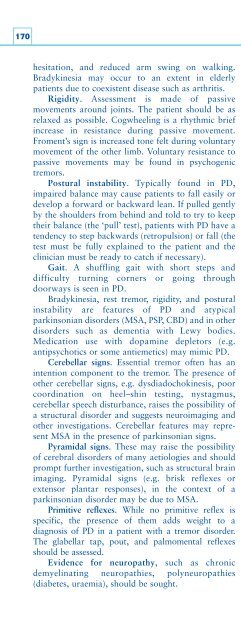You also want an ePaper? Increase the reach of your titles
YUMPU automatically turns print PDFs into web optimized ePapers that Google loves.
170hesitation, and reduced arm swing on walking.Bradykinesia may occur to an extent in elderlypatients due to coexistent disease such as arthritis.Rigidity. Assessment is made of passivemovements around joints. The patient should be asrelaxed as possible. Cogwheeling is a rhythmic briefincrease in resistance during passive movement.Froment’s sign is increased tone felt during voluntarymovement of the other limb. Voluntary resistance topassive movements may be found in psychogenictremors.Postural instability. Typically found in PD,impaired balance may cause patients to fall easily ordevelop a forward or backward lean. If pulled gentlyby the shoulders from behind and told to try to keeptheir balance (the ‘pull’ test), patients with PD have atendency to step backwards (retropulsion) or fall (thetest must be fully explained to the patient and theclinician must be ready to catch if necessary).Gait. A shuffling gait with short steps anddifficulty turning corners or going throughdoorways is seen in PD.Bradykinesia, rest tremor, rigidity, and posturalinstability are features of PD and atypicalparkinsonian disorders (MSA, PSP, CBD) and in otherdisorders such as dementia with Lewy bodies.Medication use with dopamine depletors (e.g.antipsychotics or some antiemetics) may mimic PD.Cerebellar signs. Essential tremor often has anintention component to the tremor. The presence ofother cerebellar signs, e.g. dysdiadochokinesis, poorcoordination on heel–shin testing, nystagmus,cerebellar speech disturbance, raises the possibility ofa structural disorder and suggests neuroimaging andother investigations. Cerebellar features may representMSA in the presence of parkinsonian signs.Pyramidal signs. These may raise the possibilityof cerebral disorders of many aetiologies and shouldprompt further investigation, such as structural brainimaging. Pyramidal signs (e.g. brisk reflexes orextensor plantar responses), in the context of aparkinsonian disorder may be due to MSA.Primitive reflexes. While no primitive reflex isspecific, the presence of them adds weight to adiagnosis of PD in a patient with a tremor disorder.The glabellar tap, pout, and palmomental reflexesshould be assessed.Evidence for neuropathy, such as chronicdemyelinating neuropathies, polyneuropathies(diabetes, uraemia), should be sought.General examination. Signs of metabolic upset(e.g. hyperthyroidism, hypocalcaemia, alcoholism,and hepatic disturbance) should be looked for.InvestigationsBlood tests and structural brain imaging (CT or MRI)are often needed to exclude metabolic disorders orstructural brain disease as a cause of tremor or otherinvoluntary movement. Functional neuroimagingmay be used to assess the integrity of the pre- orpostsynaptic dopaminergic neurone with SPECT orPET. Nerve conduction studies or electromyographymay be required in some cases to clarify the diagnosis.SUMMARY❏ History taking in movement disorders shouldinclude rate of onset, position, precipitants andrelievers, and full drug and family history.❏ A full neurological examination is important toperform in patients with tremor, for evidence ofother extrapyramidal signs, cerebellar features,and pyramidal signs for instance.❏ Tremor should be described in terms of site andtype (rest or action [postural and kinetic]) andamplitude of movements.❏ PD is due to degeneration of the dopamineneurones from the substantia nigra in themidbrain to the striatum. The aetiology isunknown.❏ PD is typically of unilateral onset spreading tobecome bilateral and most patients will presentwith resting tremor.❏ The cardinal features of PD are bradykinesia,tremor, rigidity, and postural instability.❏ Mimics of PD include Parkinson’s plus disorders,drug-induced parkinsonism, and vascularparkinsonism.❏ Essential tremor presents with postural andintention tremor and often shows transientimprovement with beta-blockers or alcohol.❏ Movement disorders presenting in earlyadulthood should prompt a screen for Wilson’sdisease.❏ Chorea may be due to metabolic disturbances,structural lesions, inflammatory disorders,medications, and neurodegenerative disorders.❏ Huntington’s disease presents with chorea anddementia and is an autosomal dominantdisorder.
















